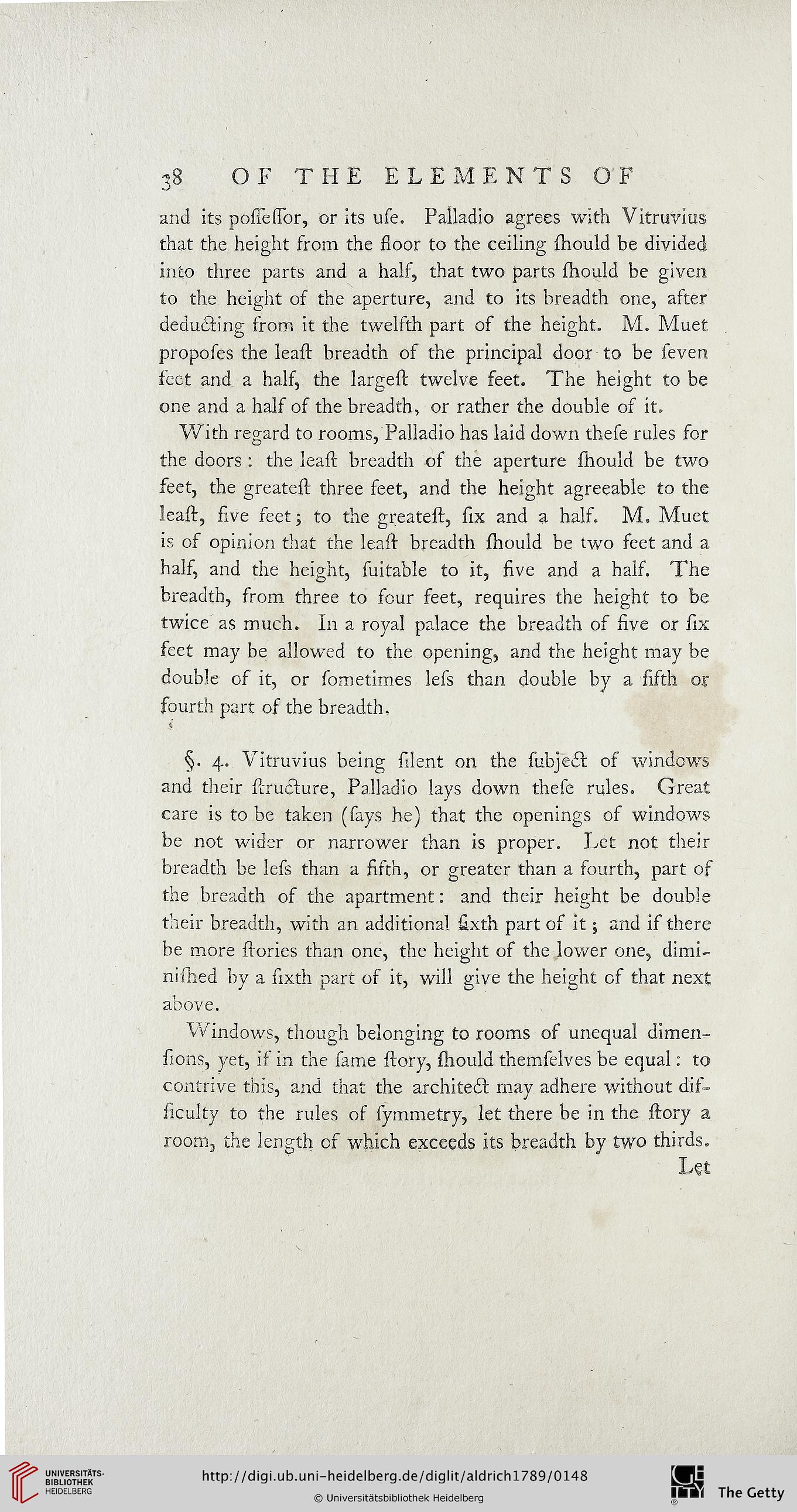38 OF THE ELEMENTS OF
and its posFessor, or its use. Palladio agrees with Vitruvius
that the height from the ssoor to the ceiling should be divided
into three parts and a hals, that two parts should be given
to the height of the aperture, and to its breadth one, after
deducting from it the twelsth part of the height. M. Muet
proposes the leas!: breadth of the principal door to be seven
feet and a half, the largest twelve feet. The height to be
one and a half of the breadth, or rather the double of it.
With regard to rooms, Palladio has laid down these rules for
the doors : the leasl breadth of the aperture should be two
feet, the greatest three feet, and the height agreeable to the
leas!:, five seet; to the greatest, six and a half. M. Muet
is of opinion that the least breadth should be two feet and a
half, and the height, suitable to it, five and a half. The
breadth, from three to sour feet, requires the height to be
twice as much. In a royal palace the breadth of five or six
feet may be allowed to the opening, and the height may be
double of it, or sometimes less than double by a fifth or
fourth part of the breadth.
§. 4. Vitruvius being silent on the subjedl of windows
and their strudlure, Palladio lays down these rules. Great
care is to be taken (says he) that the openings of windows
be not wider or narrower than is proper. Let not their
breadth be less than a fisth, or greater than a fourth, part of
the breadth of the apartment: and their height be double
their breadth, with an additional sixth part of it; and if there
be more stories than one, the height of the lower one, dimi-
nished by a sixth part of it, will give the height of that next
above.
Windows, though belonging to rooms of unequal dimen-
sions, yet, is in the same story, should themselves be equal: to
contrive this, and that the architedl may adhere without dif-
ficulty to the rules of symmetry, let there be in the story a
room, the length os which exceeds its breadth by two thirds.
Let
and its posFessor, or its use. Palladio agrees with Vitruvius
that the height from the ssoor to the ceiling should be divided
into three parts and a hals, that two parts should be given
to the height of the aperture, and to its breadth one, after
deducting from it the twelsth part of the height. M. Muet
proposes the leas!: breadth of the principal door to be seven
feet and a half, the largest twelve feet. The height to be
one and a half of the breadth, or rather the double of it.
With regard to rooms, Palladio has laid down these rules for
the doors : the leasl breadth of the aperture should be two
feet, the greatest three feet, and the height agreeable to the
leas!:, five seet; to the greatest, six and a half. M. Muet
is of opinion that the least breadth should be two feet and a
half, and the height, suitable to it, five and a half. The
breadth, from three to sour feet, requires the height to be
twice as much. In a royal palace the breadth of five or six
feet may be allowed to the opening, and the height may be
double of it, or sometimes less than double by a fifth or
fourth part of the breadth.
§. 4. Vitruvius being silent on the subjedl of windows
and their strudlure, Palladio lays down these rules. Great
care is to be taken (says he) that the openings of windows
be not wider or narrower than is proper. Let not their
breadth be less than a fisth, or greater than a fourth, part of
the breadth of the apartment: and their height be double
their breadth, with an additional sixth part of it; and if there
be more stories than one, the height of the lower one, dimi-
nished by a sixth part of it, will give the height of that next
above.
Windows, though belonging to rooms of unequal dimen-
sions, yet, is in the same story, should themselves be equal: to
contrive this, and that the architedl may adhere without dif-
ficulty to the rules of symmetry, let there be in the story a
room, the length os which exceeds its breadth by two thirds.
Let





